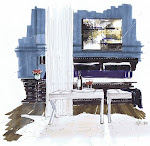I want to thank Patricia for a wonderful addition to my library…one that I will be referencing for years to come.
 I have known about the book “A Pattern Language” since the first year of college, but have never owned it. It is the second in a series of books which describe an entirely new attitude to architecture and planning. There are two other volumes in the series-
I have known about the book “A Pattern Language” since the first year of college, but have never owned it. It is the second in a series of books which describe an entirely new attitude to architecture and planning. There are two other volumes in the series-
1- The Timeless Way of Building
2- A Pattern Language
3- The Oregon Experiment
Written in 1977, at the Center for Environmental Structure in Berkeley, California, it has influenced most most Architects, Planners and Designers. It was written by Christopher Alexander, Sara Ishikawa, Murray Silverstein, with, Max Jacobson, Ingrid Fikskahl-King and Shlomo Angel.
Activity Nodes, Magic of the City, Scattered Work, Closets Between Rooms, Ceiling Ht. Variety, Car Connection, Indoor Sunlight and Life Cycle are patterns that certainly tweak my interest to know more about the language, and how to use it…about the poetry and choosing and applying it to the right subject.
The book is divided into thirds; Towns, Buildings, and Construction. Here is one example of a pattern from the first third of the book “Towns” (70)Grave Sites- page 354
“No people who turn their backs on death can be alive- The presence of the dead among the living will be a daily fact in any society which encourages its people to live” he goes on the write “Never build massive cemeteries, instead, allocate pieces of land throughout the community as grave sites-corners of parks, sections of paths, gardens, beside gateways- where memorials to people who have died can be ritually placed with inscriptions and mementos which celebrate their life. Give each grave site an edge, a path and a quiet corner where people can sit. By custom this is hallowed ground”.

It’s a small world, because last weekend, I went to see UBC’s Master of Architecture Students present their final projects, with my friend Jessica, who starts at UBC in September. One of the projects by Kelly Gartner, addressed this “living and dead scenario”
The second third of the book is titled “Buildings”.
“This completes the global patterns which define a town or a community. We now start that part of the language which gives shape to groups of buildings, and individual buildings, on the land, in thee dimensions. These are the patterns which can be “designed” or “built”- the patterns which define the individual buildings and the space between buildings, where we are dealing the the first time with patters that are under the control of individuals or small groups of individuals, who are able to build the patters all at once”
 20 years later the language was the influence for the book “Patterns of Home”. Max Jacobson (an original author of APL, along with another c0-author of APL, Murray Silverstein, wrote the book, along with Barbara Winslow. The book looks at the “ten essentials of enduring design in a residential context”. Max and Murray worked at Berkeley with Alexander from 67-74, and now all three run their own firm- JSW Architects.
20 years later the language was the influence for the book “Patterns of Home”. Max Jacobson (an original author of APL, along with another c0-author of APL, Murray Silverstein, wrote the book, along with Barbara Winslow. The book looks at the “ten essentials of enduring design in a residential context”. Max and Murray worked at Berkeley with Alexander from 67-74, and now all three run their own firm- JSW Architects.
I’m looking forward to reading every single page of Pattern Language! Thank you so much Patricia!!!















![my office 005_thumb[3] joni webb c de texas my office 005_thumb[3] joni webb c de texas](https://blogger.googleusercontent.com/img/b/R29vZ2xl/AVvXsEh91CTKAxyGdUYcWbYataer4fGFb6GUOqCg2vFA-uSoEZLLC8jwdiPTsTMcoAiNlAg7MBDiAs_0MdG-m-_tnsY-yXi0OH15JQeCcV6iIBRENxhMZbPegPBOiukZpYbkOZyueSbeaB8Yhaeu/?imgmax=800)































